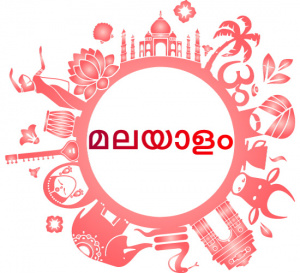Language/Malayalam/Grammar/How-to-Use-Be
Hi Malayalam learners! 😊
In this lesson, we will learn how to use the verb "be" in Malayalam. "Be" is a very important verb, as it allows us to identify and describe things and people around us. By the end of this lesson, you will be able to form sentences using "be" and understand its usage in different tenses.
Introduction[edit | edit source]
The verb "be" is used to describe the existence or state of something or someone. For example, "I am happy" or "She is tired". It is an essential verb to learn in any language as it allows us to communicate efficiently.
In Malayalam, the verb "be" is often used in the present, past, and future tenses. Knowing how to use it correctly will improve your Malayalam language skills and make communication easier. Let's dive into how to use it in different tenses.
Don't miss the chance to check out these pages as you wrap up this lesson: Give your Opinion & Negation.
Present Tense[edit | edit source]
In Malayalam, the present tense of the verb "be" is usually translated to "ഉണ്ട്" (uṇṭŭ) or "ആണ്" (āṇŭ). The former is used for inanimate objects, while the latter is used for animate objects.
Here are some examples:
| Malayalam | Pronunciation | English |
|---|---|---|
| ഞാൻ ഉണ്ട് | njaan uṇṭŭ | I am |
| അവൻ ആണ് | avan āṇŭ | He is |
| അവളും ഉണ്ട് | avalum uṇṭŭ | She also is |
| പൂവ് ഉണ്ട് | pooṵ uṇṭŭ | Flower is |
To create a negative sentence, we can use the word "ഇല്ല" (illa) which means "not." For example:
- Person 1: നമ്മൾ മുഴുവൻ ഒക്കെ പോയിരിക്കുകയാണ് (nammal muḻuvan okke poyirikkunnaayaṇŭ) (We all gone already.)
- Person 2: ഞാനും പോത്തു വന്നിട്ടില്ല (njaanum pōttu vannittilla) (I have not come yet.)
We can see how the verb "be" has been used in the above dialogue.
Past Tense[edit | edit source]
In Malayalam, the past tense of the verb "be" is usually translated to "ആയിരുന്നു" (āyirunnu) for animate objects and "ഉണ്ടായിരുന്നു" (uṇṭāyirunnu) for inanimate objects.
Here are some examples:
| Malayalam | Pronunciation | English |
|---|---|---|
| ഞാൻ പഠിച്ച വർഷം കഴിഞ്ഞിരുന്നു | njaan paṭhicc-a varṣam kajiññiruññŭ | I was studying last year |
| അവൻ ഒരു പെൺകുട്ടിയായിരുന്നു | avan oru peṇkuṭṭiyāyirunnu | He was a girl |
| പക്ഷി ഉണ്ടായിരുന്നു | pakṣi uṇṭāyirunnu | A bird was there |
Future Tense[edit | edit source]
In Malayalam, the future tense of the verb "be" is usually translated to "ആകും" (ākum).
Here are some examples:
| Malayalam | Pronunciation | English |
|---|---|---|
| ഞാൻ ഒരു ഡോക്ടർ ആകും | njaan oru ḍōkṭŭr ākum | I will be a doctor |
| അവൻ ഒരു വക്കീൽ ആകും | avan oru vakkīl ākum | He will be a lawyer |
| പുലി ഉണ്ടാകും | puli uṇṭākum | A tiger will be there |
Conversation Example[edit | edit source]
To see an example of how "be" verb can be used in a conversation, see the dialogue below:
- Person 1: ഞാന് ഭക്ഷണം ചെയ്യുന്നു (njaan bhakṣaṇam ceyyunnu) (I am eating)
- Person 2: നീ എന്ത് ഭക്ഷണം ചെയ്യുന്നു? (nī enth bhakṣaṇam ceyyunnu?) (What are you eating?)
- Person 1: ഞാന് ചിക്കൻ കറി കഴിക്കുന്നു (njaan chikkan kaṟi kaḻikkunnu) (I am eating chicken curry)
- Person 2: ഞങ്ങൾ ഒരുക്കി ഉണ്ടാക്കിയ കറി പുടിച്ചു കഴിച്ചിരിക്കുന്നു (ñaññŭḷ uṟukki uṇṭākkiya kaṟi puṭicc-u kaḻicc-irikkunnu) (We are eating the curry we made.)
In the above dialogue, we can see how "be" verb has been used to describe the state of the speakers.
Conclusion[edit | edit source]
In this lesson, we learned how to use "be" verb in Malayalam in different tenses. In Malayalam, "be" is used to describe the existence or state of something or someone. Remember that practicing with native speakers on Polyglot Club can help improve your language skills. You can also check out our Malayalam grammar section on the Polyglot Club website for more language help. വേഗം കഴിയട്ടെ! (Weɡam kazhiyatte!) (Good luck!)
➡ If you have any questions, please ask them in the comments section below.
➡ Feel free to edit this wiki page if you think it can be improved. 😎
Upon wrapping up this lesson, take a look at these related pages: Present Tense Verbs & Questions.
Videos[edit | edit source]
How to use connectives | Malayalam #grammar - YouTube[edit | edit source]
Other Lessons[edit | edit source]
- Questions
- Pronouns
- Adjectives
- How to Use Have
- Plurals
- Future Tense
- Give your Opinion
- Conditional Mood
- Negation
Sources[edit | edit source]
- Malayalam - Wikipedia
- Malayalam grammar learning software based on finite state ...
- Malayalam grammar - Wikipedia

